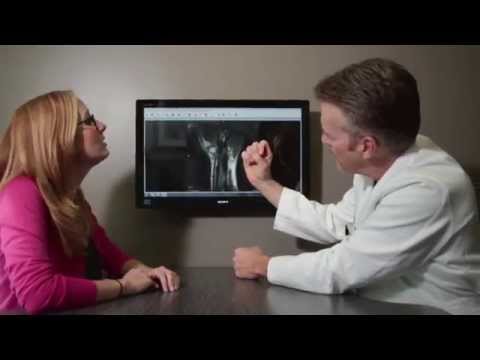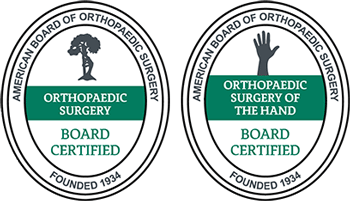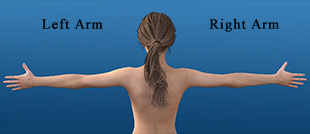Understanding Dupuytren’s Contracture vs. Trigger Finger
Dupuytren’s contracture and trigger finger are two conditions that affect the hand, but they have different causes, symptoms, and treatments. Dupuytren’s contracture involves the gradual thickening and tightening of tissue under the skin of the palm and fingers, causing one or more fingers to bend into the palm permanently. Trigger finger affects the tendons in the fingers or thumb, causing them to catch or lock when bent.
Knowing the differences between these two conditions is important to ensure an accurate diagnosis and appropriate treatment. In this article, our team at The Hand and Wrist Institute explains the distinctions, including diagnosis, treatment, and prevention tips.
Contents
What Is Dupuytren’s Contracture?

left human hand by Adrien King is licensed with Unsplash License
Dupuytren’s contracture is a condition where the tissue beneath the skin of the palm and fingers thickens and tightens over time, causing the fingers to curl inward. It often starts with small lumps or nodules in the palm, which then progress to thick cords that pull the fingers into a bent position.
The exact cause hasn’t yet been fully established, but genetic and environmental factors play a role. The condition is more prevalent among people of Northern European descent and those with a family history of it. Symptoms typically develop gradually and vary from mild stiffness to severe finger contractures. Early recognition and evaluation by a health care provider are important for determining the best treatment approach and managing the condition’s progression effectively.
What Is Trigger Finger?
Trigger finger, or stenosing tenosynovitis, affects the tendons in the fingers or thumb, which causes them to catch or lock when bent. Repetitive hand movements, underlying medical conditions such as diabetes or arthritis, or anatomical factors usually cause this condition. Symptoms include a clicking sensation, pain at the base of the affected finger, and difficulty straightening it after bending.
Unlike Dupuytren’s contracture, which involves the gradual thickening of tissue in the palm and fingers, trigger finger primarily affects the tendon sheaths and tendons. Treatment options range from nonsurgical approaches, such as splinting and steroid injections, to surgical release of the tendon sheath in severe cases.
Diagnosis and Treatment Options
Diagnosing Dupuytren’s contracture and trigger finger involves a combination of physical examination and patient history. For Dupuytren’s contracture, health care providers will examine the palm and fingers to detect nodules and thickened cords and may order ultrasound imaging. Understanding family history and previous hand conditions helps confirm the diagnosis. Diagnosing trigger finger relies on identifying the characteristic catching or locking sensation during finger movement using the Finkelstein test to recreate pain in the affected tendon sheath.
Treatment options vary. Dupuytren’s contracture may respond to nonsurgical methods such as collagenase injections or surgical interventions such as open fasciectomy. Trigger finger often responds to steroid injections initially and may require surgical release if symptoms persist. Each treatment has its own effectiveness and potential side effects, so it’s important to get expert advice when choosing the right one.
Living With Dupuytren’s Contracture and Trigger Finger
Dupuytren’s contracture and trigger finger can significantly affect your everyday life because the symptoms include limited hand mobility, pain, and discomfort. For patients with Dupuytren’s contracture, performing tasks involving fine motor skills can be challenging. This can affect work productivity, especially if you have a job that requires typing. Trigger finger can also cause pain, stiffness, and difficulty with activities requiring repetitive finger movements, such as typing or holding tools.
Here are some tips and strategies to manage these conditions:
- Resting and splinting: Rest the affected finger and use a splint to limit movement, especially during flare-ups. Depending on the severity, nonsurgical options such as splinting and physical therapy may help reduce symptoms and improve hand function.
- Heat and cold therapy: Alternating between warm compresses and cold packs can help reduce pain and inflammation in the affected hand.
- Using ergonomic equipment: Modifying how you perform tasks to reduce strain on affected fingers can be helpful. For example, using ergonomic tools or adjusting hand positions can minimize discomfort.
- Massage and stretching: Gently massage the palm and affected fingers to improve circulation and reduce stiffness. Combine with gentle stretching exercises to maintain finger extension.
Early diagnosis and treatment are essential for managing both conditions. This can prevent the condition from progressing, reducing the need for more invasive procedures. By addressing symptoms early on, you can regain confidence in your ability to use your hands.
Prevention and Long-Term Outlook
Preventing Dupuytren’s contracture and trigger finger focuses on reducing risk factors and maintaining hand health through lifestyle changes and proactive measures. While these conditions may not always be preventable because of genetic factors, the following strategies can potentially lower the risk or delay onset:
- Be mindful of hand posture and avoid repetitive gripping or strenuous activities that strain the hands excessively.
- Incorporate hand and finger stretching exercises into your daily routine to maintain flexibility and prevent stiffness. This can include simple exercises such as finger spreads, making a fist, and wrist rotations.
- Maintain a balanced diet rich in vitamins and minerals that support joint health, such as vitamins C and E.
- Stay hydrated and avoid smoking, as tobacco has been linked to an increased risk of Dupuytren’s contracture.
- Use appropriate protective gear, such as gloves, to minimize strain and protect against trauma when needed.
- Schedule regular health care appointments to monitor hand health.
While treatments for Dupuytren’s contracture can help manage symptoms and improve hand function, the condition may recur after treatment or progress over time. Complications can include permanent finger contracture, reduced hand dexterity, and difficulty performing daily tasks. Ongoing care and monitoring are crucial to address changes in symptoms and adjust treatment as needed. With the right treatment, symptoms of trigger finger often improve, but the condition can recur. In severe cases, chronic inflammation or tendon damage may cause persistent symptoms despite treatment. Long-term complications may include stiffness, limited finger mobility, and discomfort.
Regular follow-up appointments with a health care provider are essential for individuals with Dupuytren’s contracture and trigger finger to monitor the condition’s progression, assess treatment effectiveness, and make adjustments as necessary.
Take Control of Your Hand Health With The Hand and Wrist Institute
Understanding and managing conditions such as Dupuytren’s contracture and trigger finger is essential for preserving hand function and quality of life. Early diagnosis and treatment can significantly improve recovery and prevent complications. If you’re experiencing finger stiffness, nodules in the palm, or difficulty moving your fingers, schedule an appointment. Our experts can provide an accurate diagnosis, personalized treatment plans, and ongoing care to manage your symptoms. Visit The Hand and Wrist Institute for more information, consultations, and treatment options.

























